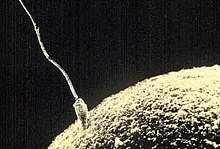Gamet

Gametes ( ancient Greek γαμέτης gametes "husband"), also known as sex cells or gametes referred to, are specialized cells , two of which are in the sexual reproduction to a zygote unite ( fertilization ).
Context: the core phase change
The zygote receives all the chromosomes of the two gametes. This doubling is compensated for at another point in the life cycle by a special form of nucleus division, the meiosis or reduction division. The change between the two nuclear phases (usually haploid and diploid ) is known as the nuclear phase change.
In humans and most multicellular animals (Metazoa), the gametes are the only haploid cells, while most body cells are diploid. These living beings are therefore called diplonts . The opposite is the case with the haplonts , in which only the zygote is diploid and all other cells are haploid. This happens in some simply organized organisms, especially thread-like green algae and flagellates .
The third form of nuclear phase change is more widespread, in which normal nuclear divisions ( mitoses ) take place in both the haploid and diploid phases and therefore haploid and diploid generations occur alternately ( diplohaplons ). This is the case with land plants ( Embryophyta ) and many algae . In the case of seed plants , however, the haploid phase is limited to the tiny embryo sac in the ovule and the pollen grain .
Some species of animals or plants have four ( tetraploid ) or six ( hexaploid ) or more sets of chromosomes in the zygote and body cells . In these cases too, the germ cells each have half as many chromosome sets and a nuclear phase change occurs accordingly.
Gamete types

|

|
|
|
A) actively motile isogametes, B) immobile isogamtes, C) gametangiogamy : fertilization without gametes in the yoke fungi
|
A) actively motile anisogametes, B) egg cell and sperm (oogamy), C) immobile anisogamete (egg cell and spermatium)
|
In some living things, especially the unicellular flagellates , the gametes look like normal cells and the fusing gametes do not differ in shape. Even with some multicellular algae , the gametes that fuse with one another cannot be distinguished from one another externally. Such gametes are called isogametes and the amalgamation of isogametes is called isogamy . Since isogametes differ physiologically, namely belong to different mating types, the cells that fuse with one another are called + gametes and -gametes (plus gametes or minus gametes).
In most living things, however, the gametes also differ externally and can therefore be assigned to different sexes, with the larger and often immobile gamete being regarded as female. If - as with many algae - the gametes of both sexes have flagella and are therefore mobile, one speaks of anisogametes and anisogamy . In extreme cases (as in humans and in all multicellular animals (Metazoa)) the female sex cell is much larger than the male and not capable of active movement. It is called an egg cell , the much smaller, mostly vigorously moving male sex cells are called spermatozoids , spermatozoa or sperm for short . The fusion of eggs and sperm is known as oogamy . In the red algae , the male gametes are also not scourged and are called spermatias .
Origin of the gametes
In most multicellular animals, the gametes arise from the germ line , which is separated from the rest of the organism ( soma ) at a very early stage of development . In various groups of simply organized animals, however, they are only derived much later from pluripotent stem cells , which can also develop into the various cell types of somatic tissues. Examples are the interstitial cells of coelenterates , the neoblasts of flatworms and the hemoblasts that circulate in the blood of the sea squirts . Plants and fungi do not have a separate germ line either. For example, the meristem in the apex of the flowering plants forms leaves during vegetative growth , but then forms stamens and carpels for reproduction .
Most organisms develop special sexual organs for the formation of gametes ( gametogenesis ) . These are called gonads in animals , gametangia in plants and fungi . In the case of gender differentiation into female and male, the female gametangia are called archegonia or oogonia and the male gametangia are called antheridia .
Web links
- Lexicon of biology: gametes
Individual evidence
- ^ Joachim W. Kadereit, Christian Körner, Benedikt Kost, Uwe Sonnewald: Strasburger - Textbook of Plant Sciences . Springer, Berlin / Heidelberg 2014, ISBN 978-3-642-54435-4 , pp. 572 , doi : 10.1007 / 978-3-642-54435-4 .
- ↑ Bernard John: Meiosis . Cambridge University Press 1990. pp. 103f.